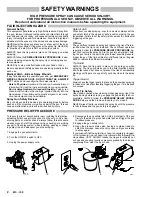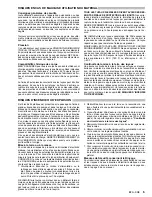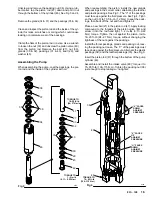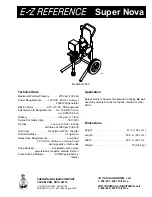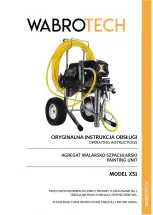
12
TROUBLESHOOTING GUIDE
This guide will help you identify the causes and solutions to sprayer problems. If you cannot identify and resolve the
problem, or if “Return for repair” is indicated, contact your nearest authorized service agency for instructions on where
and how to return the sprayer for repair.
Pressure Relief Procedure
To reduce the risk of serious bodily injury, including
fluid injection; splashing in the eyes or on the skin; inju-
ry from moving parts or electric shock, always follow
this procedure whenever you shut off the sprayer,
when checking or servicing any part of the spray sys-
tem, when installing, cleaning or changing spray tips,
and whenever you stop spraying.
1.
Engage the gun safety latch.
2.
Turn the ON/OFF switch to OFF.
3.
Unplug the power supply cord.
4.
Disengage the gun safety latch. Hold a metal part
of the gun firmly to the side of a grounded metal
pail, and trigger the gun to relieve pressure.
5. Engage the gun safety latch.
6. Open the drain valve, having a container ready to
catch the drainage. Leave the drain valve open un-
til you are ready to spray again.
If you suspect that the spray tip or hose is completely
clogged, or that pressure has not been fully relieved af-
ter following the steps above, VERY SLOWLY loosen
the tip guard retaining nut or hose end coupling and re-
lieve pressure gradually, then loosen completely. Now
clear the tip or hose obstruction.
WARNING
PROBLEM
CAUSE
SOLUTION
Electric motor won’t run
Power or extension cord is unplugged or build-
ing circuit fuse is blown
Overload switch
1
has opened
Pressure setting too low
Pressure control frozen
2
or damaged by
overpressurization
3
Check, reset or replace .
Unplug cord, relieve pressure, allow to
cool, decrease pressure. Clear dust and
overspray from motor air passages.
Increase pressure.
Thaw, change, remove or clean, re-
place; See page 18.
Electric motor stops while spray-
ing
Power or extension cord is unplugged or
damaged, or building circuit fuse is blown
Overload switch
1
has opened
Pressure setting is too low
Spray tip plugged
Wrong type extension cord
Check, reset or replace.
Unplug cord, relieve pressure, allow to
cool, decrease pressure. Clear dust and
overspray from motor air passages.
Increase.
Remove and clean.
Use maximum 200 ft. (61 m),
3 wires, 12 gauge minimum grounded
extension cord.
Electric motor runs but no output
or low output
(Also see PROBLEM,
not
enough paint pressure, on
page 13)
Piston ball check not seating
Piston packings worn or damaged
Intake valve ball check not seating
Displacement pump frozen or gear train
damaged
Pressure control frozen
2
or damaged by
overpressurization
3
Sprayer not primed
Service, see page 14.
Replace, see page 14.
Service, see page 14.
Thaw
2
, replace.
Thaw, change, remove or clean, re-
place, see page 18.
Prime, see page 8.
Electric motor labors when start-
ing; blowing fuses
Capacitor failure
Circuit board failure
Replace capacitor, see page 17.
Replace circuit board, see page 18.
Paint leaks into wet-cup
Throat packings worn or damaged
Replace, see page 14.


